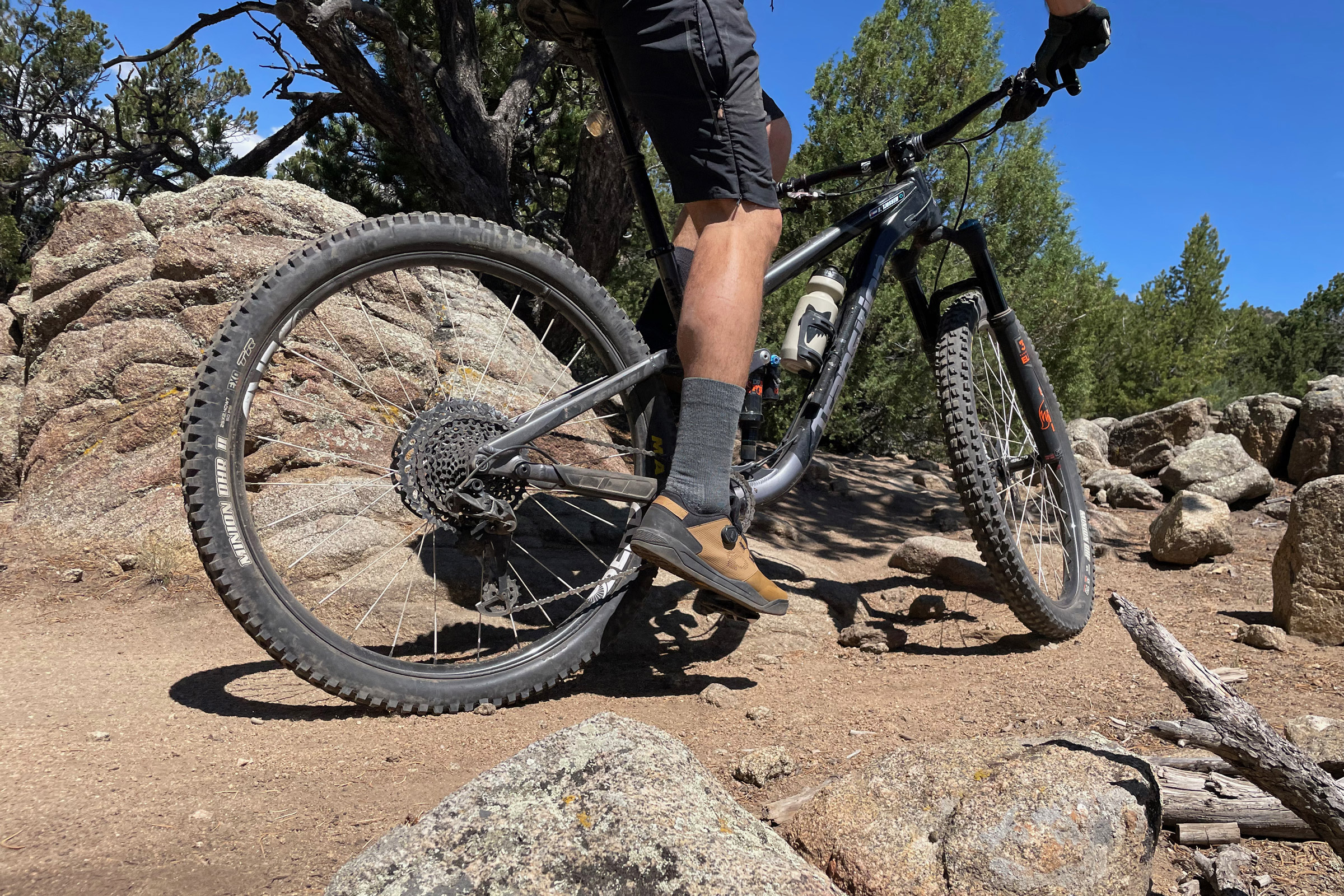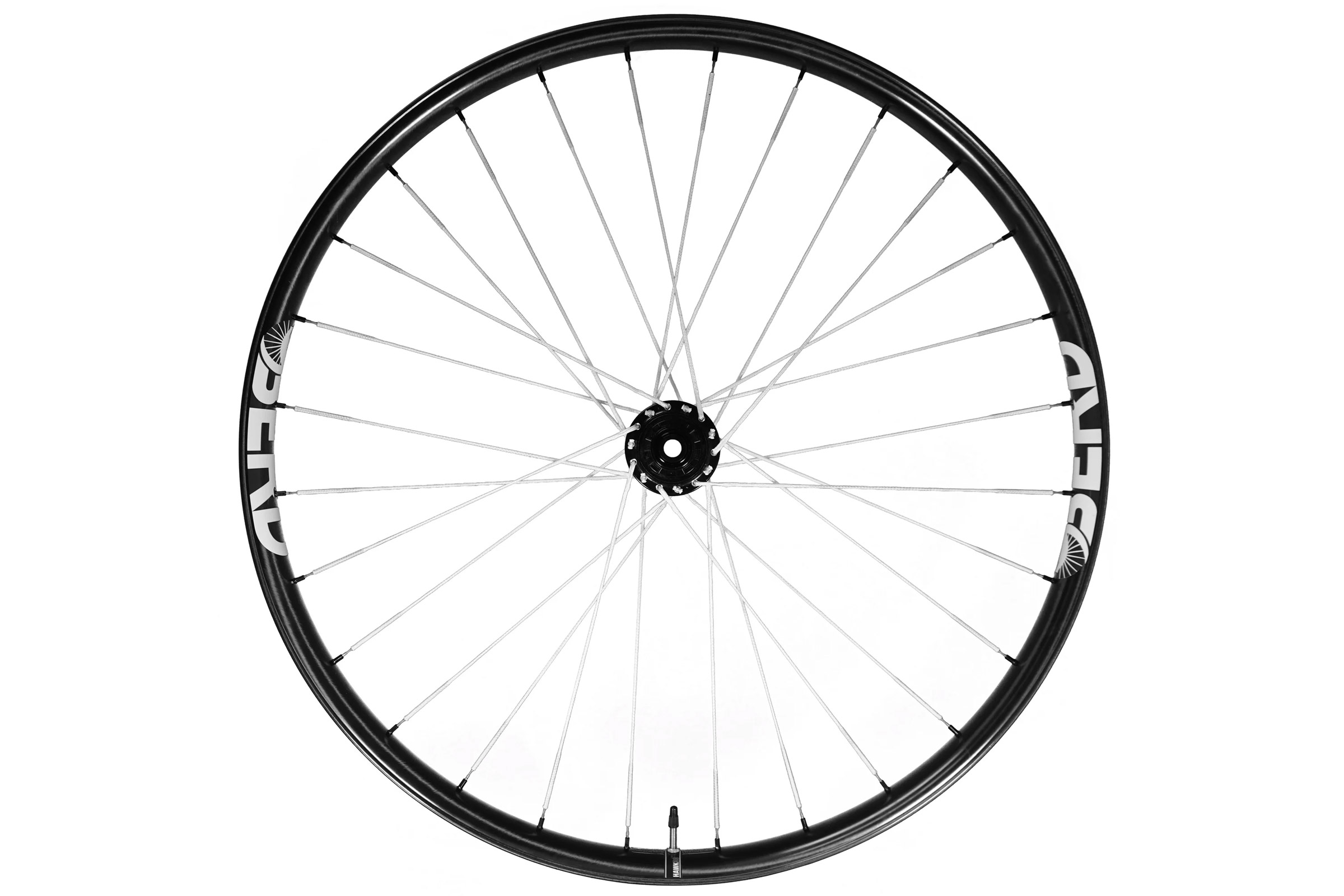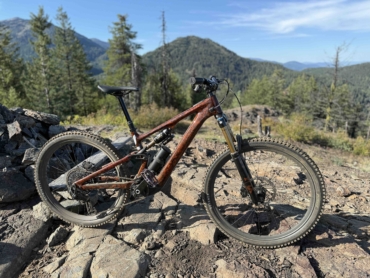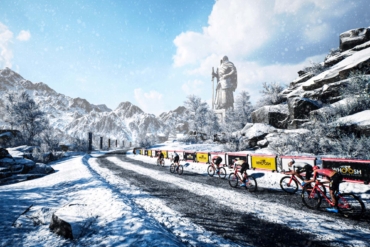I was half expecting and fully ready for the new Berd HAWK30 wheels to fold like a soft taco in my favorite high-speed corner. It’s a rutted 40-degree left-hander that has tested the limits of my wheels, ankles, and wrists for a decade. The spokes are made from braided string, after all. I took it cautiously my first time through.
I built up my confidence on the ultralight wheels over the course of a few days, one run at a time. First on a mellow bike park run, and then a rougher one at a slow pace. The wheels weren’t fazed. I ramped up to full throttle, ready to hit ol’ lefty at race pace.
I pumped and pedaled hard into it, lined it up, and leaned it over. My tires gripped and folded as my wheels ripped through the rut and accelerated, blasting a vertical roost behind me. The Berd HAWK30s didn’t flinch.
I laid it all out there on the HAWK30s. I pedaled, jumped, mashed, and bashed these 1,394g carbon wheels through the roughest terrain I could find around Colorado over 2 months. While not a long-term test, I have a lot to say about these fancy wheels.
In short: Berd’s PolyLight spokes have made quite a splash over the past few years, and for good reasons. They’re lighter and stronger than all other spokes on the market. And now Berd has rims and hubs to match in a competitively priced North American-made trail/enduro wheelset that promises strength, compliance, and durability. After 2 months of mashing them through the roughest Colorado terrain I could find, I think Berd is onto something.
Berd HAWK30 Build

The Berd HAWK30 wheels utilize their proprietary PolyLight spokes made from ultrahigh molecular weight polyethylene (UHMWPE). The brand claims it has 12 times the strength-to-weight ratio of steel. That adds up over 64 spokes.
The HAWK30 wheels come in at 1,394 g, which is extremely light even in the high-end mountain bike wheel world — a full pound lighter than some of their carbon competitors.
The Berd HAWK30 comes in several different flavors. I tested new Berd Talon hubs strung to their own carbon rims produced by another North American company, We Are One Composites. They’re shallow (18mm deep), 30mm-wide carbon rims built with compliance in mind to complement the spokes.
Setting up tubeless tires was a breeze. I added two scoops of Stans sealant, snapped the tire bead into the rim by hand, and started pumping. Both tires sealed on the first try — not bad for my 20-year-old $30 dented Park Tool pump. I set pressures to 24 psi front and 26 psi rear and didn’t think about inflation for the rest of the 2-month test period.

The Talon hubs employ a unique hook flange system that facilitates quick spoke lacing and replacement. The freehub felt like a DT Swiss hub because it essentially is. It’s sporting DT’s high-engagement (54 teeth) ratchets under the XD Driver body, a system that’s been tested and loved for over a decade.
Berd’s website also allows you to purchase custom wheels. The Talon hubs can be swapped for Industry Nine Hydra hubs, for example. You can also get Berd spokes in stealthy black instead of white (yes, please).
Lightness vs. Stiffness vs. Compliance
Dropping a pound per wheel was awesome. It wasn’t hard to notice the impact of ultralight wheels on my bike’s performance, beginning with the tried-and-true parking lot test. As you’d expect, they took less of a nudge to get going. They jumped off the starting line with the slightest pressure on the pedals. That acceleration was where the rotational weight, or lack thereof, was most recognizable.

Vail’s trails, the ones I’ve ridden hundreds of times over the last 25 years, are characterized by long, consistent, and often punchy climbs followed by equally long downhills of steep, often rooty, and sometimes rocky dirt. There isn’t a lot of rolling terrain like you find in much of the rest of the state and country. While challenging, the climbing and the descending aren’t particularly technical, save for a few downhill trails on the resort.
In this type of terrain, the lightness and lack of rotational weight were pronounced. But once I was moving on long, consistent climbs and downhills, the feeling faded. My infatuation with them eventually wore off.
It wasn’t until I went on a trip to Colorado’s Arkansas Valley that the wheels really knocked my socks off. Just an hour and a half south of Vail, the Arkansas Valley is home to markedly rocky, technical, and undulating climbing and descending.
Trails typically ride well in both directions, and you’re never fully committed to downhill or uphill mode, instead ready for a punchy climb or a technical rock drop around any corner. You’re moving slowly, changing directions often, accelerating and decelerating constantly.
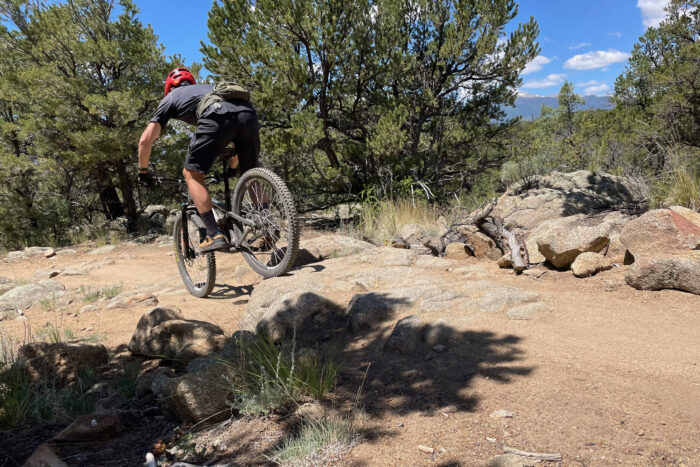
After 10 minutes on these rocky trails, it dawned on me. This is where you get the most bang for your buck out of the Berd HAWK30 wheels. The whole ride is characterized by quick, punchy accelerations, which was exactly where the HAWK30 dusted the competitors.
Acceleration was snappy and precise. Changing direction with a cutty or a front-wheel swing lift was easier. There’s so little rotating mass that I could pick them up and put them where I wanted them. Small line adjustments and slow balance moves felt predictable and efficient.
But while stiff like a traditional carbon wheel, they were far from harsh. There was a little extra compliance to cut the chatter. The spokes helped damp small bumps and take a slight edge off chunky terrain. Their overall efficiency and compliance translated to fighting the bike less and less pedal mashing through ugly, rocky terrain.
Over several hours of riding, the saved energy added up. I ended up riding better and smoother for longer, harnessing an energy-saving feedback loop.
Strava loosely confirmed my half-baked hypothesis. I didn’t punch through any of my PRs, or break many of my top 3s on my home trails in Vail, despite adding about $2,000 worth of carbon and UHMWPE to my trusty Transition Sentinel. However, I knocked off nearly all of my PRs in Buena Vista’s rocky Midland Trail System right off the bat, which I’ve ridden 20 to 30 times over the past few years.
Berd HAWK30 Durability

I’d hate to be a set of test wheels that companies send out to mountain bike testers. Even the burliest test wheels have a tough, often short life. These Berds are no different. I didn’t ride lightly because the weight of my wheels plummeted overnight.
I bashed these wheels to a pulp with honest effort. I pushed them hard into rock gardens, compressed them at full speed into rutted corners, cased and overshot plenty of jumps, landed sideways, and dropped to flat — and rode them downhill like the clock was ticking. They were super tough.
I wasn’t using a cush-core or similar insert while testing these wheels. Maxxis Minion EXO’s front and rear (24 psi and 26 psi, respectively) were the only things protecting the rims from a rocky demise. I doinked them a few times on awkwardly angled rocks, but I didn’t hit anything hard enough to question the carbon’s integrity.

The rims I was running earlier this season, aluminum WTB KOM Tough I30s, look like they had been a prop in a monster truck rally. They barely held air in tubeless mode, and I couldn’t call them circular with a straight face. That’s also what I love about aluminum rims — they can take a beating over multiple seasons without failing catastrophically.
That’s typically not the case with carbon rims. Though they usually handle small and medium dings without flinching, one big crack or slam will send them to the grave, often disastrously. It’s not often, but anyone who has worked in a bike shop knows it happens.
That’s why a good warranty can set carbon rims apart from each other. Berd is on the right side of that equation. It offers free lifetime rim replacement for the original owner, a massive benefit for anyone shelling out $2,145 for wheels.
Vibration Damping

Berd’s marketing leans heavily on the vibration-damping characteristic of its UHMWPE spokes, and it was noticeable. They made harsh terrain feel a little bit softer. It’s subtle, though.
My big, smooshy 2.5” and 2.4” Maxxis Minion tires and any enduro/trail tire play an outsized role in vibration mitigation. That much tire at relatively low pressure, with plush suspension, takes a big bite out of vibration before it gets to your grips, pedals, and saddle.
It makes sense, then, that the vibration-damping spokes would have a bigger impact in the gravel and road realms where there’s less air, tire, and suspension. Berd’s got those disciplines covered with its GVX Gravel Wheels and RD35 Road Wheels.
In the Berd HAWK30 trail/enduro category, where you’ll almost always be running a relatively plump tire, the sheer lack of rotational weight is what set them apart from the competition more so than any ride characteristic. The fancy spokes made that, and an overall superb ride, possible.
Berd HAWK30 Tradeoffs
Home mechanics around the world grimace every time another new proprietary part and matching tool are introduced to the market. Yeah, proprietary parts are annoying, but Berd makes it easy. The tools are cheap and compact, and replacement spokes are easy to order, though expensive at $8 each.
With 64 $8 spokes, all that carbon adds up. There’s no getting around the fact that the Berd HAWK30 wheelset is a lot more expensive than a solid lightweight aluminum setup at $2,145. But it’s surprisingly competitive for a carbon wheel, especially considering the tech, weight (1,394 g), strength, warranty, and made-in-North-America angle.
For comparison (from lightest to heaviest), ENVE’s M6 Wheels (1,516 g) roll in at $2,550 with an Industry Nine Hydra hub, Chris King’s MTN30 wheels (1,746 g) are $2,700, Nobl’s TR37 (1,814 g) comes in at $1,550, and Santa Cruz’s Reserve HDs with Hydras (1,829 g) land at $2,199.
In a dollar-per-gram-saved sense, Berd could charge a lot more for these wheels, and it’s awesome that they don’t.
Berd HAWK30: Conclusion
The new Berd HAWK30 wheels are some of the lightest all-mountain/trail/enduro wheels on the market. The UHMWPE spokes proved strong, and the wheelset is head-scratchingly light. The setup was a breeze, the damping and compliance were noticeable, and the acceleration was unmatched. So, what’s the catch? If there is one, I’m not sure that I’ve found it.
Sure, these wheels are priced way out of reach of the vast majority of mountain bikers out there. But, they’re still cheaper and much lighter than the big names in the high-end carbon wheel industry.
Though not a long-term test by any means, 2 months of calamitous riding led me to believe that they’re plenty durable for serious trail riding. I haven’t had to tighten a single spoke or go anywhere near a truing stand.
Riders willing to shell out the dough to give the innovative spoke concept a try will be psyched on the Berd HAWK30 wheels. Not sold on the idea? Berd will lace up your existing wheel with its UHMWPE spokes so you can experience the difference (and weight savings) before going all in.
